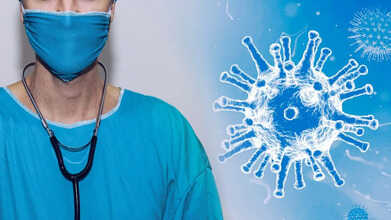- Health Conditions A-Z
- Health & Wellness
- Nutrition
- Fitness
- Health News
- Ayurveda
- Videos
- Medicine A-Z
- Parenting
Measles Cases Hit 700, Soars To Highest In 5 Years! Whooping Cough Tally Close Behind

Credits: Canva
Amid declining vaccination rates and weakened public health systems, the U.S. faces a troubling resurgence of preventable childhood diseases like measles and whopping cough. The Centers for Disease Control and Prevention (CDC), the United States has officially recorded 712 confirmed cases of measles across 24 states — the highest figure since 2019 and a number that’s rising week by week. This spike has put the nation on the brink of exceeding the 1,274 cases recorded in 2019, a milestone that would make this the worst measles outbreak in more than three decades, dating back to 1992.
The majority of cases have emerged in western Texas, where health departments are battling an outbreak that began in January. According to the Texas Department of State Health Services, 541 cases have been reported in Texas alone, a jump of 36 in just a few days.
Even more distressing: at least two confirmed deaths have occurred in school-aged, unvaccinated children, and a third fatality in an unvaccinated New Mexican adult is under investigation.
Why Are Measles Cases Suddenly Spiking Again?
Once considered eliminated from the U.S. in 2000, measles is making a worrying comeback. The key reason? Lagging vaccination rates.
The CDC has confirmed that 97% of current cases are among the unvaccinated or those with unknown vaccination status. Only a tiny fraction (3%) had received one or both doses of the measles, mumps, and rubella (MMR) vaccine, which remains over 90% effective in preventing the disease.
The agency recommends two MMR doses — the first at 12–15 months, and the second between 4–6 years of age. Still, vaccination coverage has dropped significantly since the COVID-19 pandemic, making communities more vulnerable.
Who Is Most at Risk?
Children remain the most affected demographic. The CDC reports that 11% of all measles patients this year have been hospitalized, most under the age of 19. The outbreak also places babies under one year — too young for their first MMR shot — at high risk of severe complications, including pneumonia, brain swelling, and death.
These outcomes underscore the community-wide importance of high vaccination coverage: when the majority is protected, herd immunity shields those who can’t yet be vaccinated, such as newborns and immunocompromised individuals.
Whooping Cough Isn’t Far Behind
While measles has grabbed headlines, pertussis commonly known as whooping cough is surging just as dramatically — and with deadly consequences.
After reaching historic lows during the pandemic, pertussis cases have skyrocketed by over 1,500% since 2021, with 10 deaths in 2024 — far exceeding the usual 2–4 deaths per year. Already in 2025, the CDC has documented 7,111 cases, more than double this time last year, and experts fear the numbers will spike further as we move into summer and fall.
Recent fatalities include two infants in Louisiana, a child in Washington state (its first pertussis death in a decade), and others in Idaho, South Dakota, and Oregon, where two died last year.
Why Are Vaccine Rates Dropping Fast?
The sharp rise in both measles and whooping cough can be traced back to declining vaccination rates across the U.S. According to ProPublica’s analysis of federal data, at least 36 states have seen a drop in vaccination coverage for key childhood diseases since the 2013–14 school year. In some states — notably Wisconsin, Utah, and Alaska — the drop exceeds 10 percentage points.
For instance, in Washington, kindergarten vaccination for whooping cough sits at 90.2%, just under the national average. But the coverage for toddlers between 19–35 months is just 65.4%, with some counties reporting rates below 12% — levels dangerously insufficient for community immunity.
This crisis isn’t unfolding in a vacuum. Experts point to significant federal cuts to public health infrastructure, including staffing and vaccination programs, over the past decade. On top of that, vaccine misinformation and distrust have surged — exacerbated by political figures with anti-vaccine sentiments.
Ironically, it wasn’t until two measles-related child deaths occurred in Texas that Robert F. Kennedy Jr., a known vaccine skeptic, acknowledged the importance of the MMR vaccine, calling it “the most effective way to prevent the spread of measles.” But the damage may already be unfolding.
The measles virus is one of the most contagious pathogens known, capable of spreading via airborne droplets and lingering in a room for up to two hours. A single infected individual can transmit it to up to 90% of nearby unvaccinated people.
Similarly, pertussis poses extreme danger to newborns, who can suffer from breathing pauses, brain damage, and pneumonia. The CDC urges pregnant women and caregivers of infants to receive the Tdap vaccine as a protective measure.
Yet declining trust in vaccines, paired with cutbacks to preventive care access, poses a growing risk to public health — one that could usher in the return of once-contained diseases like polio, diphtheria, and hepatitis B.
This isn’t just a momentary public health scare — it's a wake-up call. Vaccines are not just personal choices; they are public responsibilities. Each missed shot creates an opening for an outbreak, and each outbreak endangers the most vulnerable members of our society.
Measles Alert Issued After Exposure At Two Major US Airports: All You Need To Know

Credits: Canva
New Jersey health authorities have issued an alert for travelers who passed through Newark Liberty International Airport on December 19, warning of a possible measles exposure.
According to the state Department of Health, an infected passenger who does not live in New Jersey traveled through at least two airport terminals that day. Officials said anyone who was in Terminal B around 7 a.m. or Terminal C around 7 p.m. may have been exposed to the highly contagious virus. Authorities do not know where the individual was during the hours between those times.
As per NBC News, health officials have issued warnings about possible measles exposure for travelers passing through Boston and Denver.
Measles Alert Issued After Exposure At Two Major US Airports
People who were exposed could begin showing symptoms as late as January 2, as per NBC News. Health officials are urging anyone who believes they may have been exposed or who develops symptoms to contact their local health department or healthcare provider before visiting a clinic or hospital.
Officials noted that special arrangements can be made for medical evaluation to reduce the risk of spreading the virus to other patients and healthcare workers.
Measles Symptoms and Health Risks
Measles typically begins with a high fever, cough, runny nose, and red, watery eyes. A rash usually appears three to five days after symptoms start. It often begins as flat red spots along the hairline and face, then spreads downward to the neck, torso, arms, legs, and feet.
In some cases, measles can lead to serious complications, including pneumonia and encephalitis. Pregnant individuals face added risks, such as miscarriage, premature delivery, or having a baby with low birth weight.
What Is Measles?
Measles (rubeola) is a highly contagious viral infection causing fever, cough, runny nose, red eyes, and a characteristic full-body rash, spread through air and surfaces, which can lead to severe, even deadly, complications like pneumonia or brain swelling, though it's preventable with the measles vaccine, as per Mayo Clinic.
The virus is extremely infectious, with one infected person potentially infecting up to 90% of unvaccinated close contacts, and remains contagious for hours in the air or on surfaces
How Measles Spreads
Measles spreads easily through the air when an infected person coughs or sneezes. The virus can remain airborne for up to two hours after the person has left the area. Infection can also occur through direct contact with mucus or saliva from someone who is infected.
Rising Measles Cases and Protection
New Jersey has reported 11 confirmed measles cases in 2025, compared with seven cases in 2024. Across the United States, cases have climbed sharply, reaching 2,012 across 44 jurisdictions as of December 23, the highest number reported since 1992.
State health officials are working with local agencies on contact tracing and outreach to alert those who may have been exposed. Individuals most at risk include those who are not fully vaccinated or who have never had measles.
The MMR vaccine, given in two doses, remains the most effective protection against measles, mumps, and rubella.
Abhayrab Rabies Vaccine: Indian Maker Pushes Back Against Australia’s Counterfeit Warning

Credits: Canva
A government-owned Indian vaccine manufacturer has questioned a December 22 health advisory issued by Australian authorities that warned of “counterfeit batches” of an anti-rabies vaccine circulating in India since November 2023, and has formally requested that the notice be reviewed.
Abhayrab Rabies Vaccine Makers Say It Reported Single Counterfeit Case
Indian Immunologicals Limited said it had already reported a counterfeiting incident involving one batch of its anti-rabies vaccine, Abhayrab, in January, and cautioned that the Australian advisory risked creating “anxiety and mistrust” among both the public and medical professionals.
However, India’s central drug regulator has not made public whether it carried out an investigation, how widely the fake vaccine may have spread, or how many people might have received it. As a result, the scale of the incident and its possible consequences remain uncertain.
Australian Warning Highlights Risk to Travellers
The Australian advisory stated that although Abhayrab is not sold in Australia, individuals who were vaccinated while travelling in India might not be fully protected against rabies, a viral infection of the central nervous system that is almost always fatal if treatment is delayed or missed.
Abhayrab Rabies Vaccine: Details of the Australian Advisory
“Counterfeit (fake) batches of rabies vaccine Abhayrab have been circulating in India since November 1, 2023,” the advisory directed at travellers and healthcare workers said. “People who have received Abhayrab, or an unknown rabies vaccine brand in India from November 1, 2023, onwards are advised to consult their healthcare provider to assess whether replacement doses are required.”
Abhayrab Rabies Vaccine: Similar Alerts Issued by Other Countries
The Australian notice followed similar warnings elsewhere. On November 25, the US Centers for Disease Control and Prevention reported a rabies case in a traveller returning from India and referred to the circulation of counterfeit Abhayrab vaccines. A UK travel health authority had also released an alert about the falsified vaccine on October 29.
Abhayrab Rabies Vaccine: Indian Firm Warns of Public Confusion
In a communication dated December 25 to Australian health officials, Indian Immunologicals Limited said the advisory could be misunderstood and weaken confidence in vaccines, and asked that it be reconsidered to prevent confusion among healthcare providers.
The manufacturer said it has supplied more than 210 million doses of Abhayrab in India and overseas, describing it as “the most trusted brand” in the country and stating that it accounts for around 40 per cent of India’s anti-rabies vaccine market.
Abhayrab Rabies Vaccine: Details of the Counterfeit Batch
The company said the counterfeiting involved a single batch, KA-24014, which was manufactured in March 2024 and is due to expire in February 2027. This was reported to India’s Central Drugs Standard Control Organisation on January 13, 2025.
According to Indian Immunologicals Limited, the counterfeit vaccine carried the same batch number but listed a manufacturing date of November 2023 and an expiry date of October 2026. The counterfeit packaging also omitted the ₹ symbol before the printed price of 397.62.
The firm said it had urged the CDSCO in January to investigate the counterfeiting, seize the fake vaccines, and work with law enforcement agencies to identify and prosecute those responsible for manufacturing and distributing them.
Abhayrab Rabies Vaccine: No Response From CDSCO
Questions sent by this newspaper to the CDSCO on Saturday seeking updates on the status or findings of any investigation did not receive a response. Without official information from the regulator, experts say it is difficult to determine how widely the falsified vaccine may have circulated or how many people could have been affected.
Concerns Over Wording of Advisory
A scientist specialising in rabies research in India said the Australian advisory’s reference to “counterfeit batches” and circulation “since November 2023” could alarm many people who have received anti-rabies vaccines, as per The Telegraph.
“Abhayrab is a reliable vaccine and is used extensively across the country,” said Reeta Mani, professor and head of neurovirology at the National Institute of Mental Health and Neurosciences in Bengaluru. “Public advisories need precise language. People should not lose faith in vaccines.”
Rabies Burden in India
A 2022 report by the National Centre for Disease Control estimated that nearly 2.3 million people in India receive post-exposure rabies vaccines each year after animal bites, most commonly from dogs.
Research published earlier this year by the Indian Council of Medical Research estimated that rabies causes about 5,700 deaths annually in India, a reduction from earlier estimates of nearly 20,000 deaths per year.
Peer-reviewed studies have shown that thousands of people worldwide have received counterfeit rabies vaccines. This includes more than 1,600 recipients in a single Chinese province in 2010, and over 1,13,000 falsified rabies vaccine doses reported by Chinese regulators in 2018.
Why Was A Free MND Drug Denied To NHS Patients?

Credits: Canva
Although the Medicines and Healthcare Products Regulatory Agency has cleared Tofersen for use, NHS patients are still unable to receive the motor neurone disease treatment because of administrative hurdles and related problems, The Telegraph has reported.
What Is Tofersen?
Tofersen targets the underlying cause of MND in patients with a specific inherited mutation. It prevents harmful proteins from clumping together in the brain and spinal cord, a process that damages motor neurones. Doctors have reported that some patients have seen their symptoms ease after starting the drug.
MND Drug Denied On NHS
The Medicines and Healthcare products Regulatory Agency approved Tofersen for use in the UK in 2025. The drug is already available to patients in Europe and the United States. However, it is still under review by the National Institute for Health and Care Excellence, which decides whether medicines should be routinely funded by the NHS based on benefit and value for money.
While this assessment continues, Biogen, the biotechnology company behind Tofersen, has agreed to an early access arrangement with the NHS. Under this deal, the drug is being supplied free of charge on compassionate grounds.
Despite the free supply, dozens of patients are missing out. Several NHS trusts are unwilling to fund the additional costs linked to administering the treatment, such as staffing and hospital resources.
MND Drug Denied On NHS: At Least 20 Patients Denied Treatment
Data shared with The Telegraph shows that at least 20 patients have been refused access to Tofersen. The MND Association has described the situation as one where the drug could mean the “difference between life and death”.
Charity Calls for Government Action
Alex Massey, head of campaigning, policy and public affairs at the MND Association, said everyone with this form of MND should receive the drug, as per The Telegraph.
“We are talking about a small amount of extra resource for something that could be the difference between life and death,” he said. “People with MND do not have time to wait, so we urge the Government to step in and break the deadlock.”
How Common Is MND In The UK
Around 5,000 people in the UK are living with MND at any one time, and about one in 10 has a family history of the condition. Most diagnoses occur in people in their 60s, with average life expectancy ranging from two to five years.
What MND Does to the Body
MND causes the nerve cells that control movement to fail, leading to progressive weakness and mobility problems. Early symptoms often include weakness in the hands, legs or feet, making tasks such as climbing stairs or gripping objects difficult.
As the disease advances, patients may experience muscle twitching, spasms and cramps. Many develop difficulties with breathing, swallowing and speech, along with changes in mood or personality. In later stages, walking and movement can become extremely limited.
Limited Treatment Options Available
About 1,500 people are diagnosed with MND each year, yet treatment choices remain scarce. Only a small proportion of patients currently qualify for therapies that target the disease process itself.
Roughly two per cent of MND cases involve a mutation in the SOD1 gene, which causes a form of the disease known as amyotrophic lateral sclerosis. This mutation leads to faulty proteins that build up in the brain and spinal cord instead of breaking down harmful substances, damaging nerve cells.
Why Tofersen Is Different
Tofersen is designed to target this genetic fault. Clinical trials showed that the drug reduced levels of the toxic protein in spinal fluid and lowered markers of nerve damage in the blood.
The MND Association says 44 patients are currently receiving Tofersen, but at least 20 eligible patients have been refused. Only eight of the 24 specialist neurology centres capable of delivering the treatment have opted to do so.
NHS Response
An NHS spokesperson said some hospitals have worked hard to find extra staff and resources to take part in the early access programme and provide Tofersen safely to eligible patients.
They added that the NHS is encouraging Biogen to complete the Nice appraisal process, which is the only way the drug can be formally recommended as a safe, effective and cost-efficient treatment for all eligible patients in England.
© 2024 Bennett, Coleman & Company Limited

